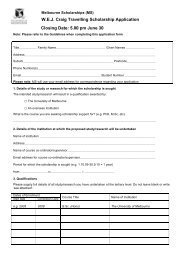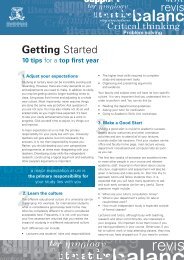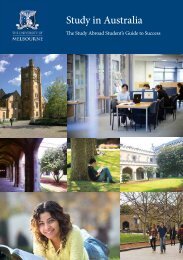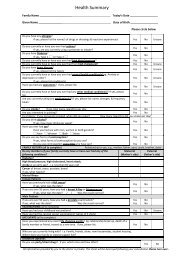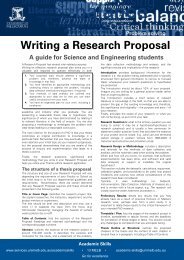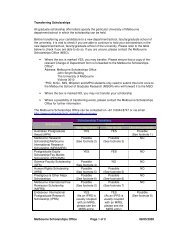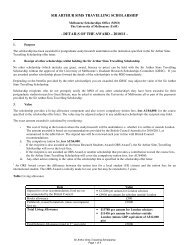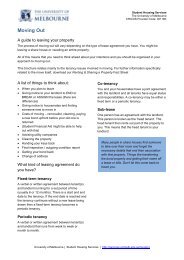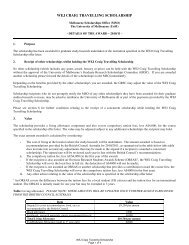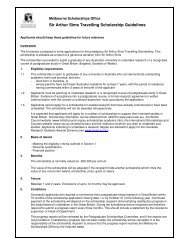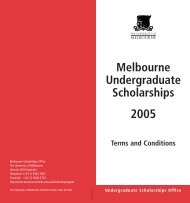Editing your writing - Student Services
Editing your writing - Student Services
Editing your writing - Student Services
- No tags were found...
Create successful ePaper yourself
Turn your PDF publications into a flip-book with our unique Google optimized e-Paper software.
<strong>Editing</strong> <strong>your</strong> <strong>writing</strong>Maximise <strong>your</strong> marks by editing <strong>your</strong> workCareful editing is vital. Errors frequently occur in <strong>writing</strong>;far more often than we realise.<strong>Editing</strong> is a process of adding to andrefining what you have written, ratherthan starting again.<strong>Editing</strong> for content Is the argument clear and consistent?In an essay it is important to clearly state <strong>your</strong> argumentas a thesis statement in the introduction; e.g. Thisessay will argue the case that … This argument shouldthen be supported throughout the paper.In a report an argument, if there is one, may emergelater, in the Discussion or Recommendations section. Are the connections between the sections clear?Paragraphs dealing with separate aspects of a topicshould be connected so that they do not look likecompletely independent pieces of <strong>writing</strong>. Each shouldbe linked logically with the paragraph before and after,so that there is a clearly defined line of argumentrunning through the entire piece of <strong>writing</strong>.Linking can be achieved in several ways: Use linking words or expressions to indicate aconnection with the previous paragraph:E.g. In light of the above …; In contrast to this … Repeat some words or phrases from the last fewlines of the preceding paragraph:For example; if the paragraph ends like this:Clearly, there was something unique in Delaroche'sstyle and technique that appealed to British audiences.The next paragraph could begin:This appeal became apparent when British audienceswere first introduced to his work at the annual exhibitionof Ancient Masters in 1938 … Are <strong>your</strong> ideas planned and presented in a logicalorder?Always write from a logically ordered and sequencedplan that outlines the main ideas covered by eachparagraph. This is useful as it informs <strong>your</strong> research; itgives you a clear framework for <strong>your</strong> <strong>writing</strong>; and it letsyou go back over <strong>your</strong> <strong>writing</strong> during editing and checkthat you have followed a logical order. Does the <strong>writing</strong> have balance?For example; is any one section too long? Look at whatyou have written in direct relation to the question. Haveyou addressed all parts of the question and written anappropriate number of words for the importance of theidea?A good place to check what is expected of you in termsof content and word count by section is the rubric andcriteria given to you by <strong>your</strong> lecturers; they are oftenquite specific about this. Have you answered the question?Simply; does <strong>your</strong> <strong>writing</strong> address the question as it hasbeen presented?<strong>Editing</strong> for organisation andstructure: paragraphsParagraphs are important because they are theframework on which <strong>your</strong> ideas are built. Does each paragraph have one main idea and is itexpressed clearly in a topic sentence?A topic sentence states the central idea of the paragraphclearly. The topic sentence is generally, but not always,the first sentence in the paragraph so it is very clearwhat the main idea is. The topic sentence acts as asignpost to <strong>your</strong> readers, letting them know thedirection the essay is now taking. For example:The first and most important reason for the AmericanRevolution was dissatisfaction with taxation by theBritish without representation. Are all sentences in the paragraph relevant to themain idea?Check that all of <strong>your</strong> sentences support the topicsentence and are relevant to the development of thepoint. Delete any sentences which may be relevant tothe general topic but not strictly relevant to the idea youare developing. Is there a set length to a paragraph?In short, no. A paragraph is an ‘idea unit’, not a unit oflength, so the length of the paragraph is consistent withthe relative importance of the idea. Paragraph length isalways determined by the relative complexity andimportance of its main point.However, a series of ‘short’ paragraphs (less than 2-4sentences) may give the impression that you have notadequately developed or substantiated the topic.Academic Skillswww.services.unimelb.edu.au/academicskills • 13 MELB • academic-skills@unimelb.edu.auGo for excellence
Short paragraphs are best used to announce a transition;a change of subject or approach, or to explain how thefollowing part of the essay is organised.Paragraphs as a rough guide, generally average around10-12 lines in a Word document. Is there a set length to a sentence?Again, no, but there are some guidelines that can behelpful. The average sentence length is 15-25 words(about 2-3 lines in a Word document). Sentences shorterthan 15 words are fine, and can have an emphaticeffect, but keep in mind that too many short sentencesgives <strong>your</strong> <strong>writing</strong> a ‘choppy’ feel to it.At the same time, don’t feel you have to write long,highly complex sentences. Sentences over 25 words areOK, but anything longer than 35 is becoming too long.Consider breaking long sentences up; idea control islessened the longer the sentence goes.<strong>Editing</strong> for expression Are the sentences complete; do they make sense?Is each sentence and idea relevant to the thesis? Isthere variety in <strong>your</strong> sentence construction? A mix ofsimple and complex sentences adds interest to <strong>your</strong>work. Check <strong>your</strong>: Punctuation - is it used appropriately? Keep in mindthat punctuation provides the 'intonation' of <strong>writing</strong>.It also indicates how ideas fit together in a sentence. Spelling - don’t rely on spellcheck, it won’t pick upmisuses such as ‘form’ for ‘from’. Referencing - have you been careful to paraphraseand acknowledge the ideas of other authors in <strong>your</strong>work? Do <strong>your</strong> references conform to departmentalguidelines as to how references should bepresented?<strong>Editing</strong> for academic styleDespite popular belief, academic <strong>writing</strong> is notnecessarily overly complicated and difficult to read.Clarity and accessibility of the message are the aims.It's worth remembering that simplicity in <strong>writing</strong> isgenerally a sign of clarity of thought.However, academic <strong>writing</strong> is formal and <strong>your</strong> <strong>writing</strong>should reflect the style and the terminology of thediscourse adopted in <strong>your</strong> subject area. So, unless youare directed otherwise, it should also be as objective aspossible (that is why ‘I’ is generally avoided), and shouldnot use contracted forms, slang and emotionallycharged words.<strong>Editing</strong> for formattingFinally, something that many people probably don’t payenough attention to; editing the formatting of thedocument.Does it look like it is supposed to? Does it requireheadings?What is the line spacing requirement? (1.5 line spacingis ‘standard’.) Do you have a heading at the bottom of apage when it should be on the next page? Have youused an appropriate font type and size? If <strong>writing</strong> areport, do you need to have a Table of Contents – whatshould be in it?Make sure you check these things against theassignment brief; they may prove the differencebetween a H1 and a H2.An editing checklistRead aloud: read the text aloud to <strong>your</strong>self. This helpsto identify parts which are not well written or don’tsound right. It can also be helpful to get someone elseto read <strong>your</strong> work. This also helps identify where topunctuate <strong>your</strong> <strong>writing</strong>.Edit when you are freshest: e.g. early in the day – not2.30 am after <strong>writing</strong> for 6 hours.Take breaks from <strong>your</strong> work: effective editing requiressome distance. Let the <strong>writing</strong> settle before you edit;leave at least 24 hours between <strong>writing</strong> and editing.Review hard copy; print it out and read paper-printedtext. We tend to ‘skim’ read and jump parts of text onscreen.Mark-up <strong>your</strong> text: Use a pen (or highlighter) when <strong>your</strong>ead to identify issues.Final-read with ruler / finger: read every line – readslowly, don’t skim or don’t skip to the next obvious error– be patient.Edit in a quiet setting: minimal distractions; no music,TV, Internet; mobile on silent.Edit for an extended period: you need to have to havea good run at it. Depending on the length of text, it mayrequire an hour or so, not 5 minutes here and there.Focus-edit: Edit for one thing at a time; edit for content/ clarity, then check through for tone, then for structure,then for typos etc.Double / Triple check final work: once it’s submitted,that’s it, it’s gone. Cautionary tale: at Academic Skills wesee students who have failed because they submittedthe wrong draft! Don’t let that be you.Further ResourcesAustralian Government Style Manual. (2002). (6th ed.) Brisbane:John WileyNordquist, R. (2011). About.com Guide. Top Ten ProofreadingTips. How to Proofread Effectively. Retrieved June 9, 2011,fromwww.grammar.about.com/od/improve<strong>your</strong><strong>writing</strong>/a/tipsproofreading.htmPurdue University Online Writing Lab. (2010). PurdueUniversity. Proofreading. Retrieved June 9, 2011, fromhttp://owl.english.purdue.edu/owl/resource/561/01/LR Communication Systems, Inc. (1999). Proofreading and<strong>Editing</strong> Tips. Retrieved June 9, 2011, fromhttp://www.lrcom.com/tips/proofreading_editing.htmAcademic Skillswww.services.unimelb.edu.au/academicskills • 13 MELB • academic-skills@unimelb.edu.auGo for excellenceV1 1012 SC



